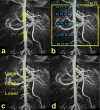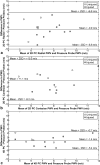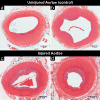Measurements of wall shear stress and aortic pulse wave velocity in swine with familial hypercholesterolemia
- PMID: 24964097
- PMCID: PMC4276731
- DOI: 10.1002/jmri.24681
Measurements of wall shear stress and aortic pulse wave velocity in swine with familial hypercholesterolemia
Abstract
Purpose: To assess measurements of pulse wave velocity (PWV) and wall shear stress (WSS) in a swine model of atherosclerosis.
Materials and methods: Nine familial hypercholesterolemic (FH) swine with angioplasty balloon catheter-induced atherosclerotic lesions to the abdominal aorta (injured group) and 10 uninjured FH swine were evaluated with a 4D phase contrast (PC) magnetic resonance imaging (MRI) acquisition, as well as with radial and Cartesian 2D PC acquisitions, on a 3T MR scanner. PWV values were computed from the 2D and 4D PC techniques, compared between the injured and uninjured swine, and validated against reference standard pressure probe-based PWV measurements. WSS values were also computed from the 4D PC MRI technique and compared between injured and uninjured groups.
Results: PWV values were significantly greater in the injured than in the uninjured groups with the 4D PC MRI technique (P = 0.03) and pressure probes (P = 0.02). No significant differences were found in PWV between groups using the 2D PC techniques (P = 0.75-0.83). No significant differences were found for WSS values between the injured and uninjured groups.
Conclusion: The 4D PC MRI technique provides a promising means of evaluating PWV and WSS in a swine model of atherosclerosis, providing a potential platform for developing the technique for the early detection of atherosclerosis.
Keywords: 4D PC MRI; PWV; atherosclerosis; familial hypercholesterolemia; pulse wave velocity; wall shear stress.
© 2014 Wiley Periodicals, Inc.
Figures






Similar articles
-
Simultaneous measurements of 3D wall shear stress and pulse wave velocity in the murine aortic arch.J Cardiovasc Magn Reson. 2021 Mar 18;23(1):34. doi: 10.1186/s12968-021-00725-4. J Cardiovasc Magn Reson. 2021. PMID: 33731147 Free PMC article.
-
Aortic pulse wave velocity measurements with undersampled 4D flow-sensitive MRI: comparison with 2D and algorithm determination.J Magn Reson Imaging. 2013 Apr;37(4):853-9. doi: 10.1002/jmri.23877. Epub 2012 Nov 2. J Magn Reson Imaging. 2013. PMID: 23124585 Free PMC article.
-
Pediatric heterozygous familial hypercholesterolemia patients have locally increased aortic pulse wave velocity and wall thickness at the aortic root.Int J Cardiovasc Imaging. 2019 Oct;35(10):1903-1911. doi: 10.1007/s10554-019-01626-5. Epub 2019 Jun 17. Int J Cardiovasc Imaging. 2019. PMID: 31209684 Free PMC article.
-
A comparison of 4D flow MRI-derived wall shear stress with computational fluid dynamics methods for intracranial aneurysms and carotid bifurcations - A review.Magn Reson Imaging. 2018 May;48:62-69. doi: 10.1016/j.mri.2017.12.005. Epub 2017 Dec 6. Magn Reson Imaging. 2018. PMID: 29223732 Review.
-
In vivo wall shear stress measurements using phase-contrast MRI.Expert Rev Cardiovasc Ther. 2007 Sep;5(5):927-38. doi: 10.1586/14779072.5.5.927. Expert Rev Cardiovasc Ther. 2007. PMID: 17867922 Review.
Cited by
-
Pulmonary 4D-flow MRI imaging in landrace pigs under rest and stress.Int J Cardiovasc Imaging. 2024 Jul;40(7):1511-1524. doi: 10.1007/s10554-024-03132-9. Epub 2024 May 31. Int J Cardiovasc Imaging. 2024. PMID: 38819601 Free PMC article.
-
Mechanosignals in abdominal aortic aneurysms.Front Cardiovasc Med. 2023 Jan 9;9:1021934. doi: 10.3389/fcvm.2022.1021934. eCollection 2022. Front Cardiovasc Med. 2023. PMID: 36698932 Free PMC article. Review.
-
2D Projection Maps of WSS and OSI Reveal Distinct Spatiotemporal Changes in Hemodynamics in the Murine Aorta during Ageing and Atherosclerosis.Biomedicines. 2021 Dec 7;9(12):1856. doi: 10.3390/biomedicines9121856. Biomedicines. 2021. PMID: 34944672 Free PMC article.
-
Abdominal applications of quantitative 4D flow MRI.Abdom Radiol (NY). 2022 Sep;47(9):3229-3250. doi: 10.1007/s00261-021-03352-w. Epub 2021 Nov 27. Abdom Radiol (NY). 2022. PMID: 34837521 Free PMC article. Review.
-
Evaluation of Plaque Characteristics and Inflammation Using Magnetic Resonance Imaging.Biomedicines. 2021 Feb 12;9(2):185. doi: 10.3390/biomedicines9020185. Biomedicines. 2021. PMID: 33673124 Free PMC article. Review.
References
-
- Gaziano JM, Wilson PW. Cardiovascular risk assessment in the 21st century. JAMA. 2012;308(8):816–817. - PubMed
-
- Den Ruijter HM, Peters SA, Anderson TJ, et al. Common carotid intima-media thickness measurements in cardiovascular risk prediction: a meta-analysis. JAMA. 2012;308(8):796–803. - PubMed
-
- Schmermund A, Erbel R. Unstable coronary plaque and its relation to coronary calcium. Circulation. 2001;104(14):1682–1687. - PubMed
-
- Taylor AJ, Burke AP, O’Malley PG, et al. A comparison of the Framingham risk index, coronary artery calcification, and culprit plaque morphology in sudden cardiac death. Circulation. 2000;101(11):1243–1248. - PubMed
Publication types
MeSH terms
Grants and funding
LinkOut - more resources
Full Text Sources
Other Literature Sources
Medical
Research Materials
Miscellaneous

